When people think of aging wines, they tend to picture dusty bottles of red lined up in a cellar, but white wines can age too, though it does depend on the wine. Aging a white will generally bring out more texture in the wine and more importantly, influence the flavors you’ll be tasting and the wine’s aromatics. Extensive aging can also alter color, making a white darker and introducing some brown and copper tones.
A Sémillon from Bordeaux can be bright and lemony when young and then develop a golden color, waxiness and hints of honey as it ages. A Riesling with a pale straw color can move from green apple and citrus to earthy flavors and a more golden color after 10 to 15 years.
What’s important to remember is that some whites are more ageworthy than others. It tends to be high acidity white wines that age best, for example the aforementioned Riesling or a Chenin Blanc. But you can also hold on to some Chardonnay, like a Puligny-Montrachet, or some of the other great whites from Burgundy.
Lastly, consider if it’s a table or a dessert wine. One of the best dessert wines in the world is Sauternes from Bordeaux which can age for decades!
Aging white vs red wine
Red wine often takes longer to resolve, which means it needs more time for all of its elements to come together. This is why people age reds. In fact, many red wines actually need to be aged so they can reach their optimum flavor profile. Aging dry, white table wine is more about how the flavors change. A white that’s been aged won’t necessarily be better, it might just be different.
Keep in mind too that drinking an older white wine can be an acquired taste. It’s not for everyone. You’ll often find a nuttiness and herbal tones are introduced into the wine’s flavor profile. If you think you should be tasting something more fruity and fresh, the change can be a bit of a shock. This is particularly the case if you were looking for a bright drinking wine, like a Sauvignon Blanc (for the record, Sauvignon Blanc is meant to be drunk young).
What makes a wine ageworthy?
It’s not necessarily the winemaker, but rather the grape varieties and the regions where the grapes are grown that determine if a wine is ageworthy or not. The wine’s acidity content, which depends on the grapes it is made from, is crucial. This is because acid helps to interrupt some of the chemical processes that make wine go bad. The overall vintage quality is also a key factor. Your best bet for aging a white wine successfully is a strong and healthy harvest year.
White wines that age well:
Riesling
Riesling is a wine with good acidity and minerality that ages beautifully. Riesling is mostly produced in Austria and Germany but also made in the Alsace region of France. It has a distinctive bottle shape that’s long and thin and you’ll typically find citrus and green apple flavors before it’s aged. There are both dry Rieslings and dessert Rieslings. A dry Reisling will develop nicely over 5-10 years and take on more earthy notes. Late-harvest Riesling, such as Auslese, is made with late-picked grape bunches and can be put away for twice as long.

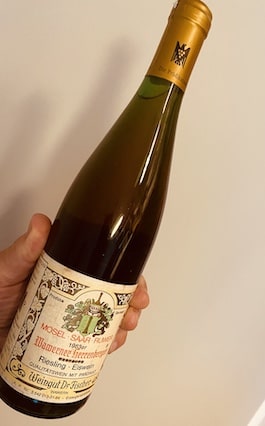
Chenin Blanc
Chenin Blanc, especially from the Loire region of France, can be made in several styles from dry, and semi-dry, to sweet dessert wine. Vouvray, Savennières and Jasnières are Chenin Blancs that have aromatics of flowers with peaches, dried fruit, honey and beeswax flavors that intensify as they get older. You can keep a dry Chenin Blanc for 7-12 years. Note, Chenin Blanc from South Africa tends to be the drier style and can also be aged.
Rioja
Rioja is a wine from Spain made from the Viura grape and it ages quite well. In fact, one producer, Marqués de Murrieta, only releases their Ygay Gran Reserva after the wine has spent over a decade in barrels, followed by extensive bottle aging. Their most recent release was a Rioja made in 1983! Nonetheless, Ygay is a special wine from a small and unique vineyard and not the standard when it comes to Rioja. An older Rioja will have more nutty and earthy tones vs the berry and fruit you’d be tasting in a younger wine.
Muscadet
An average bottle of Muscadet might just be something you drink with tonight’s dinner, but a single vineyard bottling of Muscadet can age beautifully for up to 10-12 years. The minerality and acidy in this wine means it can spend a longer amount of time on the shelf and still stay fresh and bright, keeping its citrus and fruit flavors and maintaining its saltiness. Note, the best options include estate bottled Muscadet like Clisson and Gorges which can be put away for even longer.
Verdicchio
This is a white wine from the Marche area of Italy that has lemon and citrus notes. It’s typically drunk young; however, a Verdicchio Riserva and even regular bottling Verdicchio can remain fresh for up to a decade. The reason Muscadet and Verdicchio both do so well is because they’re high in acid so the structure of the wine remains relatively stable, even after time spent in the cellar.
Sémillon
Sémillon is the major grape used in the famous Bordeaux dessert wine, Sauternes. However, in Australia, Sémillon is grown to make a white table wine with citrus notes. As it gets older, it will develop a golden color and have a certain waxiness and nuttiness to it.
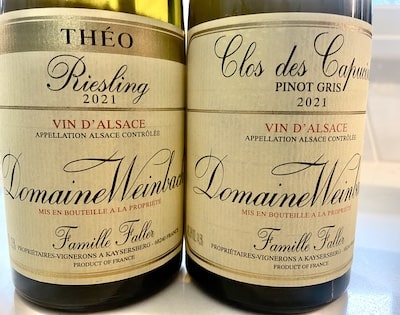
Other whites that can be aged
- Wines from the northern Rhône. The northern Rhône region in France is famous for its red wines, but you should also try their whites! Depending on the appellation, a wine from northern Rhône is usually made from the Viognier grape or a blend of Marsanne and Roussanne grapes. These are high acid wines that can age for up to 20 years. You should be tasting melon, peach, and other stone-fruits, and find they are fairly rich in texture, with some salinity. There may also be hints of oak, honey and spice. Try putting away a bottle of Condrieu, Château-Grillet, St Joseph, Saint-Péray, Hermitage, or Crozes-Hermitage, just keep in mind these wines can be expensive.
- Wines from the southern Rhône. Châteauneuf-du-Pape is a famous red from the southern Rhône region, but you can also try a Châteauneuf-du-Pape Blanc which will be similar in character to the northern Rhône whites we discussed. This wine will have Viognier, Marsanne and Roussanne grape varieties but you may additionally find Grenache Blanc, Clairette, and Bourboulenc.
- Wines from Alsace. The Alsace region in the northeast of France produces a range of white wines from bone-dry to full-flavored, including Gewürztraminer, Riesling and Pinot Gris. For the dry whites, the high acidity and minerality with generous fruit allows them to age for 10-15 years. Over time, their fruit will start to dissipate as they pick up more earthy tones. For dessert-level wines, try a Sélections de Grains Nobles or a Vendange Tardive that can age for 25+ years. The grapes used to make these wines have an elevated sugar content when they’re harvested and the wines themselves are sweet and rich with honey and concentrated stone-fruit and peach notes. They’re a treat to put away and open on a special anniversary.
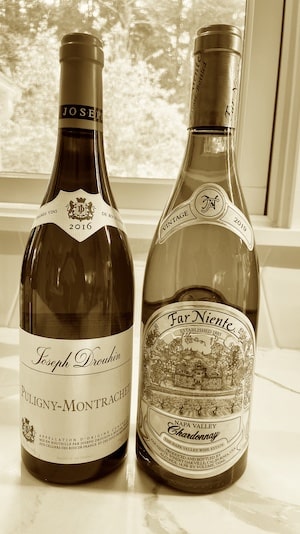
Can you age Chardonnay?
Chardonnay, in general, is made to drink in the first seven years. However, some of the more expensive Chardonnay from Burgundy, including Le Montrachet, Puligny Montrachet, Chassagne Montrachet, Meursault Premier Cru and Chablis Grand Cru can really evolve with a bit of time and be delicious up to 15 and in some cases even 20 years later. This is if the wines are stored properly in a cool dark place, like a field stone cellar.
Some of the higher priced Chardonnay from California and Oregon is also ageworthy. Just keep in mind, Chardonnay may lose some of its citrus and apple flavors and take on a more nutty and earthy tone as it ages.
Note, that when it comes to aging a Chardonnay that hasn’t seen oak, like a Chablis, it’s mainly the Grand Crus Chablis and some of the Premier Crus Chablis that do best, but it does depend on the vintage and the producer.
Dessert wine
This is a white where the grapes were usually kept on the vine longer so they have a higher sugar content at harvest. For this reason, they’re also sometimes called late harvest wines. Leaving the grapes longer means you end up with wine that is sweeter than a normal table white. The most famous include Sauternes from Bordeaux, which is made with Sémillon grapes, Beerenauslese, Trockenbeerenauslese and Eiswein from Germany, Austria and Alsace, Tokay from Hungary, and Vin Santo Trebbiano from Italy. They often have rich honey and caramel notes with good acidity. These wines all age beautifully.
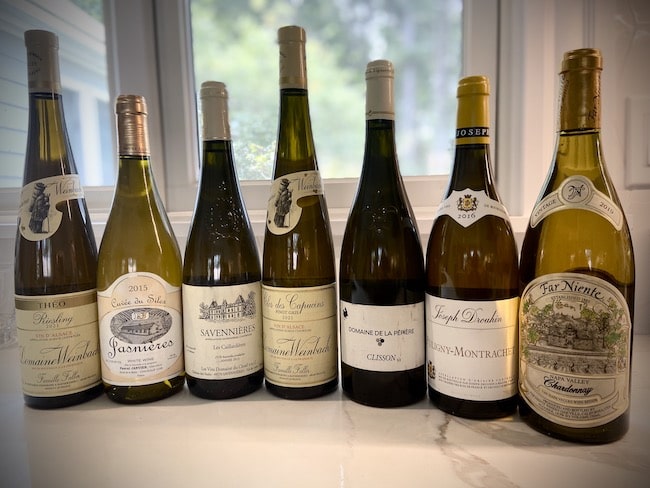
5 Questions to ask yourself before aging a white wine
- Is it ageworthy? Some wines age well, and others don’t. Your typical $10-15 Sauvignon Blanc is something you are better off drinking young. A wine that can age often has good acidity but there’s also a question of balance. Does the wine have a balance of fruit, acid and oak treatments? A young out-of-balance white wine will not evolve into a better one.
- Do you like the taste of aged whites? They’re often nutty with less rounded fruit and this is not what everyone is looking for in a white wine. If you haven’t tried one, you might want to do so before buying bottles to put away.
- Do you have a dark place to store it? If you’re going to store wine, it’s important that you keep it in a place with low light, a stable temperature and good humidity. A field stone cellar or closet floor will do and make sure you keep the wine on its side.
- Are you looking to drink the wine yourself or sell it? Some people buy wine as an investment. This is more the case for dessert whites than table wine.
- Do you have a special occasion in mind? An older white can be a unique bottle to take out on a special occasion, bring to a dinner party or offer as a gift. Just be sure the other people will enjoy tasting it too.
The best food to have with an older white
We often think of white wine as going well with seafood and the same is true for a wine that has been aged. You can pair it with lobster, shrimp, scallops and cooked shellfish. You might also try this wine with game, for example pheasant or quail. That’s because the nuttiness of the wine will complement the earthiness you’ll be tasting in the food. If you’re looking for something to serve at Thanksgiving, consider a white from your cellar instead of (or in addition to) a red. Not only will it be something special to help you celebrate with friends and family, but the wine will pair beautifully with the variety of spices in the food. Another standout is having an older white with Chinese food, especially hot full-flavored dishes, including pork. Rich and high fat food like terrines and pâté can work. In fact, a classic match for foie gras is Sauternes! Lastly, you can pair an aged white with nuts and certain cheeses, particularly blue cheese.
How to store white wine
As with bottles of red, you want to store your whites in a space that has good humidity. That’s because the cork can dry out and you might have wine seepage which can really alter the flavors and compromise the integrity of the wine. Store white alongside red and try to avoid spaces that are too warm or get any direct sunlight. Ideally, wine should stay at 55-65 degrees Fahrenheit. It’s okay if temperatures go up a bit in the summer as long as you have only a ten degree difference that’s gradual.
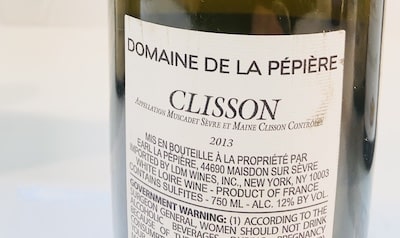
When and how should you drink it?
There’s no easy answer here. Often you might need to look up tasting notes for the exact bottle you’ve purchased to see what the winemaker or established writers say is best. Also note that sometimes a wine might not keep for reasons outside of your control. Random bottles can become too oxidized so check on the color every so often. A dry white wine that’s aging should not get too dark or brown. If you see this happening, you’ll want to open the bottle and drink it sooner rather than later.
You should chill an older white wine just as you would a younger wine. Also, when you pick up an older wine, remember to keep it horizontal until you’re ready to chill it. It may have some sediment but not like with a red that’s been aged.

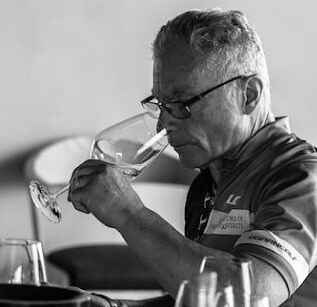
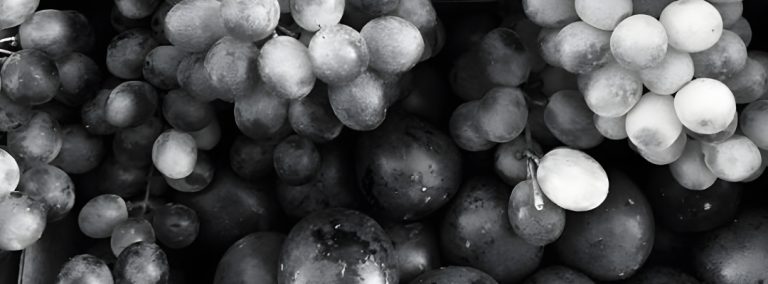



Appreciate the recommendation. Will try it out.
Great! Let us know how it goes.
Mouth-watering once again, especially that photo of the ’83 Wawerner Riesling Eiswein from Dr Fischer. An immortal sweet dessert wine with sizzling acidity from that fine producer in the Saar valley of Germany, a tributary of the Mosel. One of the various reasons why I never get bored with fine authentic wines, and compare fine wines with my kids, growing up from difficult to delightful experiences (young wines) to wonderful young adults (drinking age wine) and finally mature sensible adults (mature wines). Some wines can even hold as well as their dad and still be full of life, if the cork also holds ok without ullage which seems to be the case with that ’83 (me!)
What a great wine philosophy — Derek you of all people would know best being a winemaker in Germany as well as a father and grandfather of some lovely kids! Can’t agree more am saving that ’83 for a special occasion — maybe your next visit 🙂